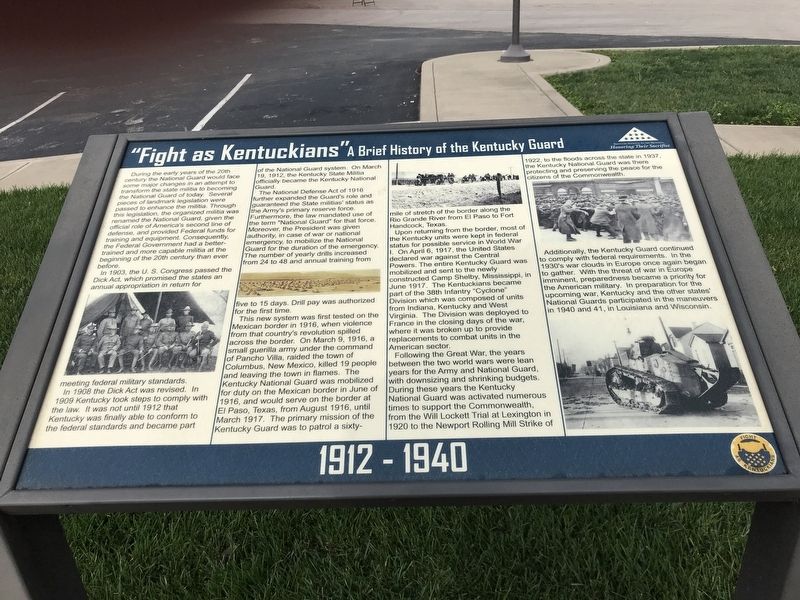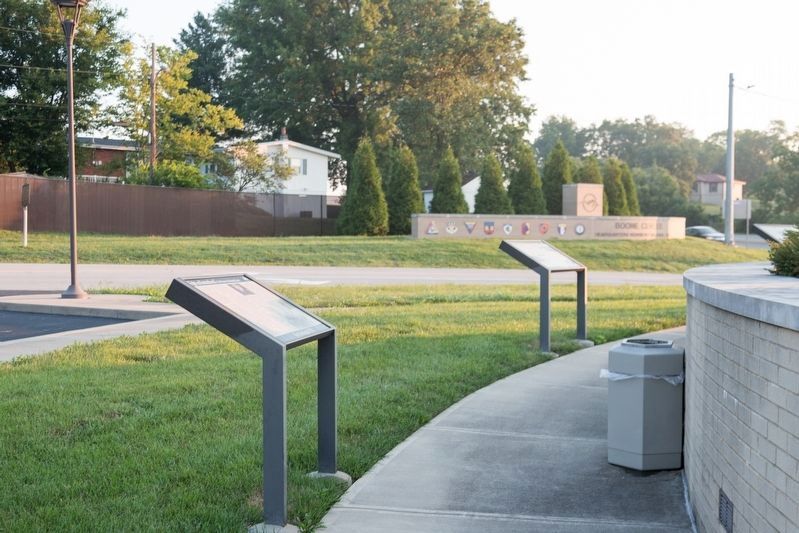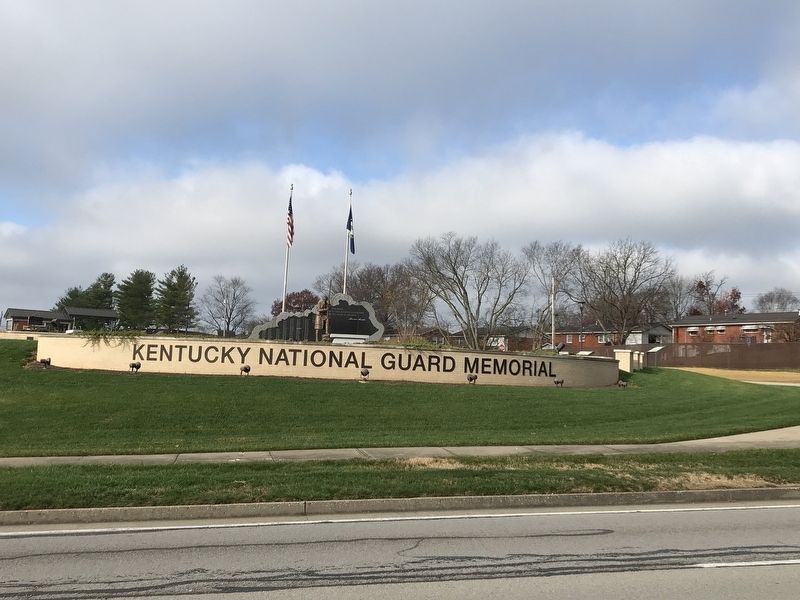Frankfort in Franklin County, Kentucky — The American South (East South Central)
"Fight as Kentuckians"
A Brief History of the Kentucky Guard
— 1912-1940 —
In 1903, the U. S. Congress passed the Dick Act, which promised the states an annual appropriation in return for meeting federal military standards.
In 1908 the Dick Act was revised. In 1909 Kentucky took steps to comply with the law. It was not until 1912 that Kentucky was finally able to conform to the federal standards and became part of the National Guard system. On March 19, 1912, the Kentucky State Militia officially became the Kentucky National Guard.
The National Defense Act of 1916 further expanded the Guard's role and guaranteed the State militias' status as the Army's primary reserve force. Furthermore, the law mandated use of the term "National Guard” for that force. Moreover, the President was given authority, in case of war or national emergency, to mobilize the National Guard for the duration of the emergency. The number of yearly drills increased from 24 to 48 and annual training from five to 15 days. Drill pay was authorized for the first time.
This new system was first tested on the Mexican border in 1916, when violence from that country's revolution spilled across the border. On March 9, 1916, a small guerilla army under the command of Pancho Villa, raided the town of Columbus, New Mexico, killed 19 people and leaving the town in flames. The Kentucky National Guard was mobilized for duty on the Mexican border in June of 1916, and would serve on the border at El Paso, Texas, from August 1916, until March 1917. The primary mission of the Kentucky Guard was to patrol a sixty-mile stretch of the border along the Rio Grande River from El Paso to Fort Handcock, Texas.
Upon returning from the border, most of the Kentucky units were kept in federal status for possible service in World War I. On April 6, 1917, the United States declared war against the Central Powers. The entire Kentucky Guard was mobilized and sent to the newly constructed Camp Shelby, Mississippi, in June 1917. The Kentuckians became part of the 38th Infantry "Cyclone" Division which was composed of units from Indiana, Kentucky and West Virginia. The Division was deployed to France in the closing days of
the war,
where it was broken up to provide replacements to combat units in the American sector.
Following the Great War, the years between the two world wars were lean years for the Army and National Guard, with downsizing and shrinking budgets. During these years the Kentucky National Guard was activated numerous times to support the Commonwealth, from the Will Lockett Trial at Lexington in 1920 to the Newport Rolling Mill Strike of 1922, to the floods across the state in 1937, the Kentucky National Guard was there protecting and preserving the peace for the citizens of the Commonwealth.
Additionally, the Kentucky Guard continued to comply with federal requirements. In the 1930's war clouds in Europe once again began to gather. With the threat of war in Europe imminent, preparedness became a priority for the American military. In preparation for the upcoming war, Kentucky and the other states' National Guards participated in the maneuvers in 1940 and 41, in Louisiana and Wisconsin.
Erected by Kentucky National Guard.
Topics. This historical marker is listed in these topic lists: War, World I • Wars, Non-US. A significant historical date for this entry is March 19, 1912.
Location. 38° 11.305′ N, 84° 53.662′ W. Marker is in Frankfort, Kentucky, in Franklin County. Marker can be reached
from the intersection of Minuteman Parkway and West Frankfort Connector. Marker is at Kentucky National Guard Memorial at entrance to Boone National Guard Center. Touch for map. Marker is at or near this postal address: 101 Minuteman Parkway, Frankfort KY 40601, United States of America. Touch for directions.
Other nearby markers. At least 8 other markers are within walking distance of this marker. A different marker also named "Fight as Kentuckians" (here, next to this marker); a different marker also named "Fight as Kentuckians" (here, next to this marker); a different marker also named "Fight as Kentuckians" (a few steps from this marker); History of Memorial Project (a few steps from this marker); Daniel Boone (a few steps from this marker); Kentucky National Guard Memorial (a few steps from this marker); Lewis and Clark in Kentucky — Kentucky Militia (within shouting distance of this marker); Welcome to Kentucky's Capitol and Capital (approx. 0.8 miles away). Touch for a list and map of all markers in Frankfort.
Related markers. Click here for a list of markers that are related to this marker.
Credits. This page was last revised on August 31, 2021. It was originally submitted on December 5, 2020, by Duane and Tracy Marsteller of Murfreesboro, Tennessee. This page has been viewed 159 times since then and 9 times this year. Photos: 1. submitted on December 5, 2020, by Duane and Tracy Marsteller of Murfreesboro, Tennessee. 2. submitted on August 31, 2021, by J. J. Prats of Powell, Ohio. 3. submitted on December 6, 2020, by Duane and Tracy Marsteller of Murfreesboro, Tennessee.


